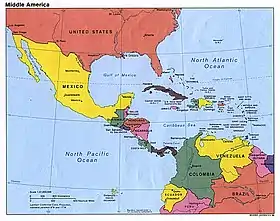Middle America (Americas)
Middle America is a subregion in the middle latitudes of the Americas. It usually includes Mexico, the seven countries of Central America, and the 13 island countries and 18 territories of the Caribbean. Together with Northern America, they form the continent of North America.
.svg.png.webp) | |
| Area | 2,728,827 km2 (1,053,606 sq mi) |
|---|---|
| Population (2007) | 188,187,764 |
| Countries | |
| Dependencies | 18
|
| GDP | $1.416 229 trillion (PPP, 2005 est.) |
| Major languages | Spanish, English, French, Mayan, Nahuatl, Antillean Creole, Haitian Creole, and others |
| Time zones | UTC−04:00 (Barbados) to UTC−08:00 (Baja California) |
| Largest cities | |
Colombia and Venezuela of South America are sometimes included in this subregion. The Caribbean is occasionally excluded from this subregion while Bermuda and The Guianas are infrequently included.[1][2][3]
Geography

Physiographically, Middle America marks the territorial transition between Northern America and South America, connecting yet separating the two.[4] On the west, the Middle American mainland comprises the tapering, isthmian tract of the American landmass between the southern Rocky Mountains in the southern United States and the northern tip of the Andes in Colombia,[5] separating the Pacific Ocean on the west and the Atlantic Ocean (viz. the Gulf of Mexico and Caribbean Sea) on the east, while the Greater and Lesser Antilles form an island arc in the east.[4] The region developed subaerially southward from North America as a complex volcanic arc-trench system during the Early Cretaceous period, eventually forming the land bridge during the Pliocene epoch when its southern end (at Panama) collided with South America through tectonic action.[6]
Countries and territories
Small island nations are excluded. Puerto Rico is in italics due to not being independent.
| Country / Territory | Population | Area (km2) | Density (people
per km2) |
Capital |
|---|---|---|---|---|
| 127,575,529 | 1,943,945 | 65.6 | Mexico City | |
| 17,581,472 | 107,158 | 164.1 | Guatemala City | |
| 11,333,483 | 109,883 | 103.1 | Havana | |
| 11,263,770 | 27,557 | 408.7 | Port-au-Prince | |
| 10,738,958 | 48,329 | 222.2 | Santo Domingo | |
| 9,746,117 | 111,888 | 87.1 | Tegucigalpa | |
| 6,545,502 | 119,994 | 54.5 | Managua | |
| 6,453,553 | 20,720 | 311.5 | San Salvador | |
| 5,047,561 | 51,049 | 98.9 | San José | |
| 4,246,439 | 74,333 | 57.1 | Panama City | |
| 2,948,279 | 10,831 | 272.2 | Kingston | |
| 2,933,408 | 9,104 | 322.2 | San Juan | |
| 390,353 | 22,805 | 17.1 | Belmopan | |
| 389,482 | 9,997 | 39.0 | Nassau | |
| Total | 217,193,906 | 2,667,593 | 81.4 | – |
Use of the term Middle America as synonym
Occasionally, the term Middle America is used synonymously with Central America[3] (compare with Middle Africa and Central Africa). In English, the term is uncommonly used as a synonym of the term Mesoamerica (or Meso-America),[5][7] which generally refers to an ancient culture region situated in Middle America extending roughly from central Mexico to northern Costa Rica.[8] In addition, some residents of the region (e.g., Costa Ricans and Nicaraguans) may be referred to as Meso-Americans or Central Americans, but not, however, as Middle Americans, which refers to a particular constituency in the United States.[9]
See also
Notes
- Sometimes included.
- Administered by the United States, claimed by Haiti.
References
Citations
- CIA political map of Middle America. 1994. Perry–Castañeda Library Map Collection; University of Texas Library Online
- "Middle America." Merriam-Webster's Collegiate Dictionary, 11th ed. 2003. (ISBN 0-87779-809-5) New York: Merriam-Webster, Inc.
- Augelli, John P. (June 1962). "The Rimland-Mainland Concept of Culture Areas in Middle America". Annals of the Association of American Geographers. 52 (2): 52 (2): 119–129. doi:10.1111/j.1467-8306.1962.tb00400.x. JSTOR 2561309.
Mexico, Central America, and the West Indies, to which the term is normally applicable, share a general [geographic] focus .... For some ... "Middle America" refers only to Mexico and Central America; others add the West Indies and, infrequently, even Colombia, Venezuela, and The Guianas. Occasionally, the term "Central America" is used synonymously with "Middle America". Also, German geographers often refer to just the isthmian territories from Panama to Guatemala as Mittelamerika.
- Gonzalez, Joseph. 2004. "Middle America: Bridging Two Continents" (ch. 17). The Complete Idiot's Guide to Geography. (ISBN 1-59257-188-3) New York: Alpha Books; pp. 213–7
- "Middle America." Encyclopædia Britannica 2006. Chicago: Encyclopædia Britannica, Inc.
- Coney, Peter J. 1982. "Plate tectonic constraints on the biogeography of Middle America and the Caribbean region." Annals of the Missouri Botanical Garden: v. 69, pp. 432–443
- 'Glossary' Archived 2007-09-30 at the Wayback Machine Images of the Past, 4th ed. 2005. McGraw-Hill Higher Education.
- Dow, James W. 1999. The Cultural Anthropology of Middle America Archived 2007-07-04 at the Wayback Machine.
- "American." The Oxford Companion to the English Language (ISBN 0-19-214183-X). McArthur, Tom, ed., 1992. New York: Oxford University Press, p. 35.
Sources
- "Middle America", Dictionary.com.
- "North America". The Columbia Encyclopedia, 6th ed. 2001–6. New York: Columbia University Press.
- Oxford English Reference Dictionary, 2nd ed. (rev.) 2002. (ISBN 0-19-860652-4) Oxford, UK: Oxford University Press.